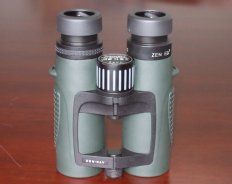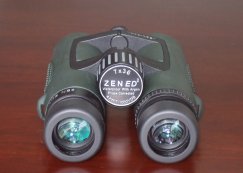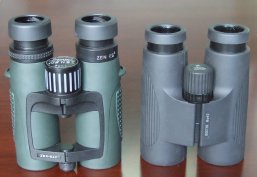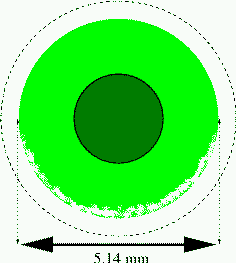


Binoculars for travel and trek have got their own special requirements: They should not be too heavy, but sufficiently powerful and rugged to deliver the performance and reliability which we expect on our tour - after all, we spend a lot of money for the trip and expect to obtain a maximum return in terms of nature experience. With the compact binoculars of the 20mm class being too limited in their performance, and the "full-sized" 42mm glasses already quite big and heavy, many travelers choose the 8x30 as their companion, and in most situations it is the Nikon 8x30 EII which I use to take out on my trips.
The 8x30 does without any doubt offer an excellent compromise, being compact and with a wide field of view, but it is also suffering one notable weakness: With less than 4mm exit pupil, its performance under low light remains rather limited. The 7x35 class follows a different approach to compromise size and performance: It is more compact than the 42mm "full size", but, contrary to the 8x30, offers 5mm exit pupils which extend their range of application towards the low light regime. In this short review, I shall report on my experience with the new Zen-Ray 7x36 ED2 binocular, which I have used over a period of 4 weeks.
The Zen-Ray 7x36 ED2 (2009). Right: Size comparison with the Docter 8x42 B/CF
Zen-Ray is a binoculars brand, established in recent years in the USA, which offers quality binoculars manufactured in China. These 7x36 binoculars are made in Kunming, but I have never seen them being sold anywhere in China and had to order them from US. The 7x36 ED2 is a member of Zen-Ray's premium line, offering a couple of modern features such as open bridge design, low dispersion glass to minimize chromatic aberration, a dielectric prism coating, and it is fully water proof with Argon gas filling. The wide angle oculars have got a long eye-relief for spectacle wearer, and the eye-cups are of the twist-up type which can be locked at one intermediate position. The objective caps are attached to prevent them from getting lost. The body is made of a lightweight but rugged magnesium alloy. The Zen-Ray ED line also contains a 8x43 and 10x43 binocular. On Internet, I found price tags for the 7x36 which varied between 370 US$ and 650 US$.
The following table contains a couple of specifications:
| Real angle | Apparent angle | Eye relief | Exit pupil | Weight | |
| of view (deg) | of view (deg) | (mm) | diam. (mm) | (gram) | |
| Zen-Ray 7x36 ED2 | 9.1 | 64 | 17 | 5.2 | 700 |
The Zen-Ray is shipped together with a robust hard case which is protecting the binocular during transport. Zen-Ray had already informed me via email prior to its arrival that, upon inspection, the objective covers were found to be too loose and that a replacement would be shipped later. This incident indicates a good attitude towards customers support. It also exhibits the difficulties an ambitious binoculars importer is still facing when dealing with Chinese manufacturers who are not always willing to pay attention to engineering details.
The first impression about the Zen-Ray 7x36 concerns its fairly big size - it is as big as my Docter 8x42 B/CF, but also 100g lighter. I am using the Docter 8x42 as a replacement for my Nikon 8x30, whenever I need extra exit pupil size for low light conditions or expect to use it in poor weather (the Nikon EII is not waterproof), so, when considering its size, the Zen-Ray is naturally competing with the Docter. Its finish appears to be of high quality, and all moving parts indicate a precise machining, operating smoothly and without any mechanical play. I am particularly impressed about the focuser, a big wheel which operates truly accurately, much superior to most of the focusing devices I have seen on other Chinese binoculars. The wheel for diopter setting on the right hand barrel can be locked so that an unintentional turn is avoided. The twist up eye cups are also operating rather precisely. My only complaint would address the fact that they lock at one single intermediate position only: To my taste, the fully extended eye cups are a little far out, so that I cannot cover the entire field of view, while the intermediate position is already too close and generates kidney beaning. One or two additional locks would come handy here. With fully collapsed eye cups, the eye relief should be sufficient for most spectacle wearers who want to enjoy the entire field of view.
This field of view is in fact very wide - and bright! There is no visible color tint of the image, which seems to have a slightly cooler (bluish) touch than my Docter 8x42 B/CF. The contrast and sharpness are excellent in the central region of the image, a tad superior even to the Docter's, and on a same level with the Nikon EII. The star test reveals that star images remain point-like over about 70% of the field (radially, measured from the center), which is also a good result for a wide angle binocular. This binocular is therefore able to deliver pleasant wide angle views into the night sky and might find its followers among amateur astronomers. The street lantern test reveals the coating to be state of the art - the number and intensity of ghost images remains low. Roof prism binoculars, and in particular those made in China, do often display 'spikes' of high intensity when a street lantern is spotted in the night - a result of the diffraction of light at the roof edge, which becomes particularly apparent if the roof edge was machined under loose tolerances. The Zen-Ray does show these spikes, but at rather low intensity, which indicates prisms of high quality. There is a visible pincushion distortion, which is useful to eliminate the globe effect of the panning binocular. It seems to me that the distortion is somewhat high, a little more than would be necessary to avoid the globe effect, so there is a slight overcorrection visible while panning. A true drawback, however, is the stray light behavior of this binocular: It tends to reflect diffuse light into the field of view, which becomes worse in twilight situations when the eye pupil begins to expand and to touch the peripheral region of the exit pupil. As a result, whenever there are shadowed areas to be observed, e.g. below trees, with bright sky or other light sources surrounding the field of view, then this diffuse stray light tends to reduce the contrast and, in certain situations, significantly affects the observations. Such kind of problems might show up with most binoculars, but in this case they are more severe than average and hence define a significant weakness of this binocular. After all, a 7x36 binocular, with its 5.1mm exit pupil, will certainly be used under twilight conditions and here the stray light is more often than not causing a degradation of the otherwise very bright and crisp image. Remark: The stray light problem is solved, see the November update below.
In summary, this is a quality binocular, perhaps being the best one among those 'Made in China' glasses which I have tested so far, certainly superior to the Chinese 8x40 glasses presented a couple of months ago. Its mechanical and optical features are of high quality, and in some disciplines, like field of view and image contrast, surpassing the performance of my Docter 8x42 B/CF (which however is a pre-2008 version, an upgraded version of the Docter with improved coatings is available by now). Some people might complain about the bulk of this device, but considering its wide field of view, demanding larger prism dimensions, I regard its size tolerable. The stray light problem, however, has to be addressed by the design team, because it is significantly pulling down the overall score of this (otherwise) fine binocular. If, additionally, its eye cups were further improved, to offer more than a single inter-lock position, then this Zen-Ray 7x36 ED would qualify as a replacement for my Docter 8x42 B/CF (which is of the 600 Euro league), whenever I need the low-light performance or the weather resistance that my 8x30 Nikon EII cannot offer. In any case, it is good to know that a fine binocular of the 7x35 class is back on the market - with just a few further improvements, it could be able to challenge competitors of the upper middle class (i.e. of a price range between 500 and 1000 Euro), such as Docter, Meopta, or the Nikon HGL series.
 I was asked a couple of times by now whether or not the stray
light mentioned above might be present with every sample or
the result of quality scattering. Or whether there might
exist a correlation with certain facial-anatomic properties
of the individual observer. Apparently, some seem to experience
this 'glare', while others do not.
I was asked a couple of times by now whether or not the stray
light mentioned above might be present with every sample or
the result of quality scattering. Or whether there might
exist a correlation with certain facial-anatomic properties
of the individual observer. Apparently, some seem to experience
this 'glare', while others do not.
I believe the answer is really simple: The figure to the left displays a simple sketch of the exit pupil (light-green circle) which has got a diameter of 5.14mm. In a typical situation, there is a bright sky above the observer, which causes light to enter through the front lenses of the binocular and to illuminate some glossy structures inside the tubes. As a result, there is a certain stray light contamination visible around the lower edge of the exit pupil (which I have indicated with a fuzzy, white cloud). As long as the observer's eye pupil remains much smaller than the exit pupil (dark-green circle), it easily avoids that region and there is no problem. If, after sunset, or inside a forest, the eye pupil diameter is reaching or exceeding the exit pupil diameter (dashed circle), then it covers the contaminated area and the stray light turns problematic. Since it is way out of focus, it appears as a fuzzy crescent which can cover major areas of the field of view.
Obviously, there exist inter individual differences. The eye pupils of some individuals may never exceed 5mm (which would more frequently be the case with elder people), or only under very low light, and for those there exists no stray light problem at all!
The described problems are particularly pronounced with the 7x36 because of its wide angle of view and the corresponding wide light cone. The 10x43 has got a much narrower angle of view and may not suffer this stray light problem, while the 8x43 may be somewhere in between. This problem can be avoided by placing properly dimensioned stray light baffles inside the objective tubes. Self-made lens hoods may also be worth trying.
I have now inspected an upgraded version of the Zen-Ray 7x36 which has got a fix for the stray light problem. One may easily detect the following changes:
Left: An additional baffle in front of the prism entrance. Right: Grooved walls
According to Zen-Ray, another baffle has been installed inside the eyepiece. The new model is marginally heavier, 710g instead of 700g. The field test shows that the stray light intensity is significantly reduced, down to perhaps 30% of its original intensity. The remaining amount is on the same level found with other, sometimes more expensive binoculars, and no longer an issue.
I am impressed how fast Zen-Ray has been able to address that problem. The new binocular does now exhibit a very well balanced performance pattern and can be regarded to play inside the upper middle class league, superior to the Vortex Razor and almost on the level of Docter/Meopta. This is a great achievement for its price, and I am curious how this binoculars line will develop further in the coming years.
Last modified: November 2009